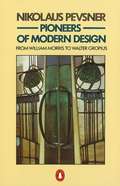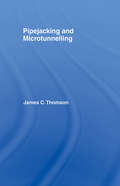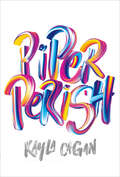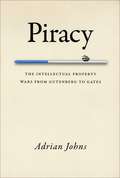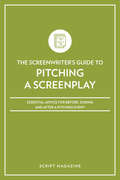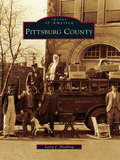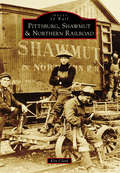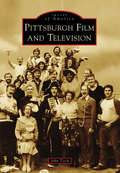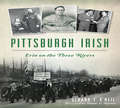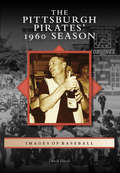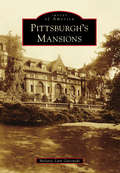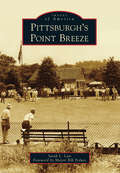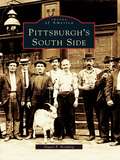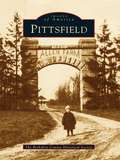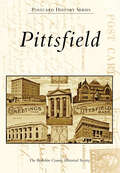- Table View
- List View
Pioneer Quilts: Prairie Settlers' Life in Fabric
by Lori Lee Triplett Kay TriplettDiscover the history and culture of America&’s pioneers chronicled in quilts and learn how to create your own inspired designs. Join fictional character Esther Heinzmann as she narrates the journey through authentic, pioneer-era creations from the Poos Collection—each featured in full color on a 2-page spread. Ideal for traditional quilters and quilt history buffs, this robust offering of 30 antique quilts also includes 5 quilt projects that readers can recreate at home. Offering access to the authors&’ privately held family collection, this book gives an in-depth look at the importance of quilts to the pioneer life. As you view the quilts, you'll also read accounts of the Westward Expansion, including information on preparation for the long journey and a depiction of real life on the prairie.
Pioneers of Armour in the Great War: In The Great War
by David A. Finlayson Michael K CecilPioneers of Armour in the Great War tells the story of the only Australian mechanized units of the Great War. The 1st Australian Armoured Car Section, later the 1st Australian Light Car Patrol, and the Special Tank Section were among the trailblazers of mechanization and represented the cutting edge of technology on the Great War battlefield.The1st Armoured Car Section was raised in Melbourne in 1916, the brainchild of a group of enthusiasts who financed, designed and then built two armored cars. Having persuaded the Australian Army of the vehicles' utility in the desert campaign, the armored car section, later re-equipped with Model T Fords and retitled the 1st Australian Light Car Patrol, provided valuable service until well after the Armistice.The First World War also saw the emergence of the tank which, despite unpromising beginnings, was to realize its potential in the crucial 1918 battles of Hamel and Amiens. A British Mark IV tank which toured Australia in 1918 demonstrated the power of this new weapon to an awestruck Australian public.Much of the story of the armored cars is told in the voices of the original members of the section and in newspaper articles of the time which highlight the novelty of these vehicles. Painstaking research has produced a remarkable collection of images to accompany the narrative, many never previously published. Biographies of the members of these extraordinary units are also a feature of this book, their stories told from the cradle to the grave. Appendixes provide a wealth of supporting biographical and technical information that enriches the text and adds factual detail.
Pioneers of Modern Design: From William Morris to Walter Gropius
by Nikolaus PevsnerOne of the most widely read books on modern design, Nikolaus Pevsner's landmark work today remains as stimulating as it was when first published in 1936. This expanded edition of Pioneers of Modern Design provides Pevsner's original text along with significant new and updated information, enhancing Pevsner's illuminating account of the roots of Modernism. The book now offers many beautiful colour illustrations; updated biographies and bibliographies of all major figures; illustrated short essays on key themes, movements, and individuals; a critique of Pevsner's analysis from today's perspective; examples of works after 1914 (where the original study ended); a biography detailing Pevsner's life and achievements; and much more. Pevsner saw Modernism as a synthesis of three main sources: William Morris and his followers, the work of nineteenth-century engineers, and Art Nouveau. The author considers the role of these sources in the work of early Modernists and looks at such masters of the movement as C.F.A. Voysey and Charles Rennie Mackintosh in Britain, Sullivan and Frank Lloyd Wright in America, and Adolf Loos and Otto Wagner in Vienna. The account concludes with a discussion of the radical break with the past represented by the design work of Walter Gropius and his future Bauhaus colleagues. Nikolaus Pevsner (1902-1983), a distinguished scholar of art and architecture, was best known as editor of the 46-volume series The Buildings of England and as founding editor of The Pelican History of Art.
Pious Fashion: How Muslim Women Dress
by Elizabeth BucarFor many Westerners, the veil is the ultimate sign of women’s oppression. But Elizabeth Bucar’s take on Muslim women’s clothing is a far cry from this attitude. She invites readers to join her in three Muslim-majority nations as she surveys pious fashion from head to toe and shows how Muslim women approach the question “What to wear?” with style.
Pipe Drafting and Design
by Roy A. Parisher Robert A. RheaPipe Drafting and Design, Fourth Edition is a tried and trusted guide to the terminology, drafting methods, and applications of pipes, fittings, flanges, valves, and more. Those new to this subject will find no better introduction on the topic, with easy step-by-step instructions, exercises, review questions, hundreds of clear illustrations, explanations of drawing techniques, methodology and symbology for piping and instrumentation diagrams, piping arrangement drawings and elevations, and piping isometric drawings. This fully updated and expanded new edition also explains procedures for building 3D models and gives examples of field-scale projects showing flow diagrams and piping arrangement drawings in the real world. The latest relevant standards and codes are also addressed, making this a valuable and complete reference for experienced engineers, too. Provides tactics on the drafting and design of pipes, from fundamentals to detailed advice on the development of piping drawings, using manual and CAD techniques Covers 3-D model images that provide an uncommon opportunity to visualize an entire piping facility Includes exercises and questions designed for review and practice Introduces the latest 3D modeling software programs and 3D scanning systems
Pipejacking & Microtunnelling
by James ThomsonCovers development of trenchless technology; pipejacking and microtunnelling methods equipment: shields and tunnel boring machines; pipejacking: line, drive pit, top side; equipment: microtunnelling; design concepts.
Piper Perish
by Kayla Cagan&“A love-letter to the artistic life, filled with glamour, passion, hunger and heartbreak.&” —Hope Larson, New York Times–bestselling, Eisner Award–winning author and illustrator Debut author Kayla Cagan breathes new life into fiction in this dynamic, authentic book. Warhol-obsessed Piper will have readers asking big questions along with her. What is love? What is friendship? What is family? What should I wear? Piper Perish inhales air and exhales art. The sooner she and her best friends can get out of Houston and get to New York City, the better. Art school has been Piper&’s dream forever, and now that senior year is halfway over, she&’s never felt more ready. But in the final months before graduation, things are weird with her friends and stressful with three different guys, and Piper&’s sister&’s tyranny thwarts every attempt at happiness for the Perish family. Piper&’s art just might be enough to get her out. But is she brave enough to seize that power when it means giving up so much? &“There may not be another book published this year that is more perfect for artistic, complicated Cancers who love stability yet crave adventure.&” —Teen Vogue &“It&’s the Cinderella story for any artsy kids.&” —Marika McCoola, New York Times–bestselling author &“Cagan tells Piper&’s story with amazing authenticity . . . Soulful reading for any artistic teen with a dream.&” —Booklist &“Debut author Cagan has created a lively and memorable protagonist in Piper Perish, a young artist full of angst, joy, hope, and creativity.&” —Publishers Weekly
Pipsqueaks: Itsy-Bitsy Felt Creations to Stitch & Love
by Sally DixonHandcraft the tiniest and cutest felt critters imaginable—from blushing bunnies and kitties to a teeny-weeny bear and a dainty dog.Whether you’re young or just young at heart, this book will satisfy your appetite for cuteness. A whopping 31 tiny hand-sewn felt projects range from pint-size koalas and elephants to miniature strawberries and ice cream cones. A glossary of stitches and a techniques chapter are included as guides, along with easy-to-follow patterns for each project. You’ll need only a handful of supplies (embroidery floss, felt, a few beads) to bring these adorable critters and accessories to life. The size of the projects makes them perfect for being made into earrings or brooches, too—the cutest new additions to your accessory collection.Patterns for 31 tiny animals and accessories all in one book make this an outstanding valueA glossary, tips, and hand-sewing techniques make these projects friendly even for novice craftersProjects are tiny enough to be transformed into quirky and whimsical jewelry“Besides tiny elephants, there are clear and detailed instructions for creating winsome mice, a budgerigar puppet, tiny dogs, bunnies & kittens, plus designs for two different koalas and a platypus in a peekaboo bed . . . In addition to clear patterns and instructions, I found some excellent crafting advice in this book.” —We Bloom Here“Quick to make and super cute! There are lots of things in this book to love. I also feel that it would make a great gift for a crafty youngster (don’t forget to throw in some pieces of felt!).” —My Handmade Adventure
Piracy: The Intellectual Property Wars from Gutenberg to Gates
by Adrian JohnsBrimming with broader implications for today's debates over open access, fair use, and free culture, Johns argues that piracy has been an engine of social, technological, and intellectual innovations as often as it has been their adversary.
Pit Bull Heroes: 49 Underdogs with Resilience and Heart
by Greg MurrayA celebration of forty-nine pit bulls doing a world of good, from the photographer behind Peanut Butter Dogs.Pit Bull Heroes spotlights forty-nine good boys and girls who beat the odds and became heroes in their families, neighborhoods, and communities. Meet Chad, found on a street corner, who now serves as the first pit bull in the pet therapy program at Children&’s Hospital of Philadelphia; Apollo, who finished first in his police training and now sniffs out narcotics at his full-time job in Washington State; and Charlie, who rallied an entire community to fight breed-specific legislation laws in Lakewood, Ohio. All pit bulls; all heroes in their own way. Animal advocate and photographer Greg Murray captures these pit bull heroes in their day-to-day lives and shares their inspiring stories. Also included are helpful resources to show how you, too, can become an advocate for pit bulls and animal safety in your community.&“A heartwarming testament to the incredible value dogs have in our lives. Greg captures these special friendships beautifully with his remarkable photography.&” ―Maggie Marton, Oh My Dog blog&“I hope and believe this inspiring, joyful book will help more dogs get adopted into homes so they can become heroes, too.&” ―Arin Greenwood, author of Your Robot Dog Will Die
Pitching a Screenplay: Essential Advice for Before, During and After a Pitching Event
by Jeanne Bowerman Script Magazine EditorsCongratulations! You've written the next blockbuster hit! But...now what?Writing your screenplay is just the first step. If you don't take it out into the world and pitch it, your script will never get sold. Pitching a Screenplay: Essential Advice for Before, During and After a Pitching Event can help you take that next step. This collection of articles from Script Magazine will take you through the ins and outs of crafting and delivering a truly impressive pitch.Just how valuable are pitchfests? These articles explore what you can really expect to get out of spending your time and money at pitchfests. You will learn about pitchfest misconceptions and how networking and building relationships with producers can be the most valuable takeaway from any pitching event. You will learn how to prepare for a pitchfest: what research you need to conduct, what to bring, what to wear, and how to begin. These articles cover how to make a great first impression, the dos and don'ts of pitching, what phrases will make you sound like a rookie during a pitch meeting, and important tips to know before submitting your script. You will learn the 5 steps for pitching success, which include concentrating on the needs of the producers besides your own and turning rejection into connection. Pitching a Screenplay: Essential Advice for Before, During and After a Pitching Event also delves into the importance of listening, having both a prepared and improvisational phase of your pitch, and knowing your weaknesses.Contributors to this collection include Jeanne Veillette Bowerman (editor for Script Magazine), Lee Jessup (career coach to notable screenwriters), Jacob Krueger (writer of The Matthew Shepard Story), Stephanie Palmer (leader of the American Film Market's annual Pitch Conference), and Wendy Kram (producer and owner of L.A. FOR HIRE).Don't let your script gather dust of the shelf! Take the next step toward getting your vision produced with help from Pitching a Screenplay: Essential Advice for Before, During and After a Pitching Event.
Pittsburg
by Marti AielloSituated at the far reaches of the Bay Area, Pittsburg has long been perceived as a commuter town, an out-of-the-way bedroom community. Yet this city has a rich and varied history stretching back to the early days of statehood and has played an important role in commerce, both to the state and to the Bay Area. Before long the burgeoning city had a fishing industry rivaling that of San Francisco's famed Fisherman's Wharf and a largely Italian fishing community. By the 1900s, a surprising number of industries set up factories along the waterfront property of Pittsburg. In 1942, the beginning of World War II brought the building of Camp Stoneman, an important departure point for many servicemen. Later, the city became known as a residential destination. Readers of this book will surely see Pittsburg in a new light as they enjoy the surprising and varied tales of the city's previous generations.
Pittsburg County
by Larry J. HoeflingNorth of the thick pine and oak forests of the Ouachitas Mountains, in the foothills beyond the Kiamichi and the Winding Stair Mountains, two trails crossed in the rolling valley nestled between the Shawnee Hills and the Sans Bois Mountains. In the early 1800s, that valley became the home of the Mississippi Choctaw tribe, part of the U.S.-designated Indian Territory. When the railroad boom of the late 1800s occurred, the tracks followed the same cattle trails and pioneer roads, creating a transportation hub at the point where rail lines intersected, a place that later became the county seat of Pittsburg County.
Pittsburg, Shawmut & Northern Railroad (Images of Rail)
by Ken ClarkThe Pittsburg (no "h"), Shawmut & Northern Railroad was described by locals as a railroad that "started nowhere and ended no place, with a lot of nothing in between," although it actually linked the coal mines of Elk County, Pennsylvania, with markets in Cattaraugus, Allegany, and Steuben Counties in central and western New York State. Always an underdog, the Class I line went into bankruptcy a mere five years after its corporate birth, holding the record for the longest receivership of any American railroad at 42 years. Always starved for cash, it limped along with outdated and tired equipment, yet it never failed to meet its payroll. It was scrapped completely in 1947.
Pittsburgh Film and Television
by John TiechCelebrated as the home of the first nickelodeon, Pittsburgh operated as a significant part of the film industry for the first 30 years of the 20th century. Unfortunately, the emergence of Hollywood and the evolution of the industry crippled Pittsburgh. Despite hard times, the Steel City avoided extinction and eventually became a cinematic powerhouse with the emergence of television and location filmmaking. Shows such as Chiller Theater and Studio Wrestling and movies like The Silence of the Lambs, The Deer Hunter, Night of the Living Dead, and The Dark Knight Rises are all part of Pittsburgh's rich entertainment history, which began in 1898. Pittsburgh proudly continues to produce film and television for a worldwide audience of all ages.
Pittsburgh Irish: Erin on the Three Rivers (American Heritage)
by Diane V. Byrnes Gerard F. O'NeilPresbyterians from the Irish province of Ulster were among the first to push the wild frontier west and found the city of Pittsburgh. By the 1840s, the flow of Irish Catholic immigrants had become a flood. Fleeing the great hunger and facing resentment in the city, they established themselves as key members of the community, building railroads and canals and establishing schools, hospitals and fraternal orders. During the Civil War, 156 women, many of them Irish, made the ultimate sacrifice for their new country when the Allegheny Arsenal exploded. The Fenians fought Southern Rebels under a green flag and made a little-known invasion of Canada in 1866. In the twentieth century, the sons and daughters of Erin took on roles as political leaders, labor agitators and entrepreneurs. Exploring tales of saints, sinners and visionaries, author Gerard F. O'Neil offers a beguiling and fascinating history of the Pittsburgh Irish.
Pittsburgh Pirates' 1960 Season, The (Images of Baseball)
by David FinoliIn the history of the Pittsburgh Pirates, no team has beenmore memorable than that of 1960. In the decade before,the team produced only two winning records: a second-placefinish in 1958 and in 1959. In 1960, they put it all togetherto win the pennant. Their reward was a trip to the WorldSeries against the favored New York Yankees. In theYankees' three winning games, they outscored Pittsburgh38-3, but the Pirates were able to win three to send it toGame 7. In one of the most exciting contests in the historyof the sport, the Pirates came up in the bottom of the ninthwith the score tied. At exactly 3:36 p.m., Bill Mazeroskihit a home run over the left field wall to give the Pirates amemorable championship. This book tells the story of thatmagnificent team and its glorious victory, which will beetched into the minds of Pittsburgh baseball fans forever.
Pittsburgh Sports Firsts (Sports)
by Alliance of Esteemed Duquesne ScribesCountless groundbreaking moments in the nation's sports history were made on the gridirons, courts, fields, ice rinks and ballparks of Pittsburgh. Duquesne's Chuck Cooper was the first African American player drafted by the NBA. Beloved local radio station KDKA produced the first-ever broadcast of a Major League Baseball game. The Pittsburgh Stars were the first NFL champions in 1902. The first nighttime World Series game was played in the Steel City, and the only game seven World Series walk-off homerun happened there too. The city boasts compelling claims as the birthplace of pro hockey, pro football and college basketball. Some of the most preeminent authors and sports historians of Western Pennsylvania capture the vivid moments that make Pittsburgh a city of historic sports firsts.
Pittsburgh Streamlined Trolleys
by Kenneth C. SpringirthPittsburgh Streamlined Trolleys covers the history of the trolley car system that once had the third largest fleet of Presidents' Conference Committee trolley cars in North America. Pittsburgh Railways Company was very innovative and constantly made design improvements in its trolley cars. This led to increased ridership, as these streamlined trolleys were quiet, fast, and had comfortable seating. With the increased use of automobiles, ridership declined. After the Port Authority of Allegheny County took over Pittsburgh Railways, most of the trolley routes were abandoned. However, a number of trolleys were refurbished with paint schemes that included psychedelic commercial advertising and community messages. The last runs of these trolleys occurred in 1999, and new light rail vehicles are now in service.
Pittsburgh's East Liberty Valley
by East End/East Liberty Historical SocietyPittsburgh's East Liberty Valley originally consisted of lush hunting grounds used by many Native American groups. In the 1700s, British general John Forbes instructed George Washington to build a military road from Fort Ligonier through the East Liberty Valley to the forks of the Ohio River. In 1758, Forbes traveled this widened trail, first named for him, now known as Penn Avenue. Many plantations were established after the Revolution, and the village grew, with its tollhouse and taverns serving stagecoaches and Conestoga wagons en route to Pittsburgh. By the 20th century, East Liberty was one of the wealthiest suburbs in America. Many famous firsts occurred here, including the building of the nation's first gasoline service station and the founding of the National Negro Opera Company. The area also boasts many famous residents, including Billy Eckstine, Erroll Garner, Gene Kelly, Dick Powell, and Lillian Russell. Through vintage photographs, Pittsburgh's East Liberty Valley salutes the area's rich history.
Pittsburgh's Mansions
by Melanie Linn GutowskiIn the 19th century, the positioning of Pittsburgh as a major manufacturing center and the subsequent rise of the area's steel industry created a wave of prosperity that prompted the beneficiaries of that wealth to construct extravagant residences. Wealthy enclaves sprang up in the city's East End, across the river in neighboring Allegheny City, and into the countryside. Pittsburgh's Mansions explores the stately homes of the area's prominent residents from the 1830s through the 1920s. Businessmen such as H.J. Heinz, Henry Clay Frick, and members of the Mellon family commissioned elaborate homes from the preeminent architects of their day. Firms such as Alden & Harlow, Janssen & Abbott, and Rutan & Russell left their marks on the city's landscape, often contributing iconic public buildings as well as expansive private homes. Though many of the residences have since been lost, Pittsburgh's Mansions offers a look back at the peak of the city's prominence.
Pittsburgh's Point Breeze
by Mayor Bill Peduto Sarah L. LawNamed for the famous early-19th-century Point Breeze Hotel that stood at the corner of what is now Fifth and Penn Avenues, Point Breeze has been home to some of the wealthiest families in Pittsburgh and the country. Moguls such as Carnegie, Westinghouse, Frick, Mellon, and Thaw all resided in Point Breeze, thus christened "Pittsburgh's Most Opulent Neighborhood." H.J. Heinz owned the first car in Pittsburgh, which was garaged at his estate in North Point Breeze, and present-day Wilkins Avenue was originally the private road to the 650-acre estate of senator, ambassador to Russia, and judge William Wilkins. However, many of these prestigious estates were later razed and divided to become smaller residential lots, driving the real estate market to create more homes to accommodate 20th-century families. In later years, the Point Breeze neighborhood became the home of several well-known authors, including Annie Dillard, Albert French, and David McCullough, as well as professional athletes Willie Stargell of the Pirates and L.C. Greenwood of the Steelers and everyone's favorite neighbor, Mr. Rogers.
Pittsburgh's South Side
by Stuart P. BoehmigIn 1763, King George III granted 3,000 acres of bottomland on the south side of the Monongahela River to Maj. Gen. John Ormsby for his service in capturing Fort Duquesne during the French and Indian War. Just 100 years later, this flat river plain became the center of the "Workplace of the World." Powerful industrial giants such as B. F. Jones, James Laughlin, and Henry W. Oliver were drawn to the area, making it the heart of the Industrial Revolution. Immigrants came in droves from Germany, Ireland, Scotland, England, and later from central and Eastern Europe. They crowded Carson Street with the sights and sounds of different languages, customs, and fashions. These were the people who made the steel and iron that built America. Pittsburgh's South Side is their story, a story of glass factories, steel mills, incline planes, trolley cars, saloons, and the crowded row houses where they raised their families.
Pittsfield (Images of America)
by The Berkshire County Historical SocietyPittsfield is truly the heart of the Berkshires.The Berkshire Hills of western Massachusetts have long been a cultural hub and an area of exceptional natural beauty, and Pittsfield, the area's largest community, has always been at the center of attention. The town center, now known as Park Square, was the site of the first agricultural fair ever held in the United States, and Pittsfield became well-known as the adopted home of such literary luminaries as Oliver Wendell Holmes and Herman Melville, who wrote his classic novel Moby-Dick at his home, Arrowhead. In addition to Pittsfield's rich cultural heritage, the town's commerce and industry have fueled the region from the early days when Arthur Scholfield operated the only wool-carding machine in America, to the city's more recent role as an innovator in the electrical industry. Pittsfield celebrates the scenic beauty, the cultural heritage, and the ingenuity of the people and places of the town using nearly 200 vintage images. Inside find Pittsfield's famous sons and daughters, scenic novelties like Balance Rock, the diving horses that performed at Pontoosuc Lake, and even the famous trolley wreck that almost killed Theodore Roosevelt.
Pittsfield (Postcard History Series)
by The Berkshire County Historical SocietyPittsfield is truly the heart of the Berkshires. The Berkshire Hills of western Massachusetts have long been a cultural mecca and an area of exceptional natural beauty, and Pittsfield, the area's largest community, has always been at the center. The town was the adopted home of such literary luminaries as Oliver Wendell Holmes and Herman Melville, who wrote his classic novel Moby-Dick at his home, Arrowhead. The common at the center of town, now known as Park Square, was the site of the first agricultural fair ever held in the United States. The town's commerce and industry have fueled the region from the early days when Arthur Scholfield operated the only wool-carding machine in America, to the city's more recent role as an innovator in the electrical industry. Pittsfield celebrates the scenic beauty, the cultural heritage, and the inventiveness of the people and places of the town using nearly two hundred vintage images. Inside find Pittsfield's famous sons and daughters, scenic novelties like Balance Rock, the diving horses that performed at Pontoosuc Lake, and the famous trolley wreck that almost killed Pres. Theodore Roosevelt. Also see images from 1850 to 1950 that document life in Pittsfield and illustrate the town's pivotal role in the cultural and economic life of the Berkshires.


